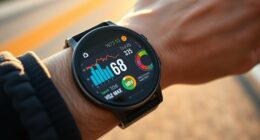To guarantee your treadmill runs accurately, you’ll want to regularly calibrate it and check belt speed. Start by turning off and unplugging your machine, then inspect and clean sensors near thebelt and motor area using a soft cloth or compressed air. Tighten loose connections and follow your manufacturer’s calibration routine, which may involve running the belt at specific speeds. Proper maintenance and calibration keep your treadmill performing safely and effectively—continue with this guide to learn detailed steps and tips.
Key Takeaways
- Proper calibration ensures the belt speed displayed matches the actual speed, providing accurate and safe workout conditions.
- Regular sensor cleaning and inspection prevent dust or debris from impairing belt speed measurements.
- Many treadmills feature built-in calibration routines accessible via the control panel for precise belt speed adjustments.
- Tightening loose wires and ensuring sensors are properly connected maintains sensor accuracy and responsiveness.
- Consulting the user manual or a professional technician helps ensure correct calibration procedures for optimal belt speed precision.

Ensuring your treadmill is properly calibrated is essential for accurate belt speed and a safe workout. When your treadmill’s sensor accuracy isn’t reliable, it can cause discrepancies between the displayed speed and your actual pace, which might lead to overexertion or injury. Regular calibration helps maintain the precision of these sensors, guaranteeing the machine responds correctly to your inputs and provides consistent performance. To achieve this, you need to understand and follow proper maintenance procedures, which include inspecting sensor connections, cleaning sensor components, and recalibrating the system when necessary. Remote work practices highlight the importance of routine maintenance to sustain productivity and efficiency, which parallels the need for regular treadmill upkeep. Sensor accuracy is the backbone of a well-functioning treadmill. Many modern models rely on sensors to monitor belt speed, incline, and other parameters. Over time, dust, dirt, or even loose connections can impair sensor performance, leading to inaccurate readings. That’s why periodic maintenance procedures are critical. You should start by turning off the treadmill and unplugging it from the power source. Once safe, inspect the sensors near the belt and motor area for signs of dust buildup or damage. Use a soft cloth or compressed air to gently clean the sensors, ensuring they are free from debris that might interfere with their signals. If you notice any loose wires or connectors, tighten or replace them as needed. Proper sensor maintenance assures that the signals they transmit remain accurate, which directly impacts the overall calibration of the treadmill. Calibration involves more than just cleaning; it often requires recalibrating the system to align the sensor readings with actual belt speed. Many treadmills have built-in calibration routines accessible through the console or control panel. Follow the manufacturer’s instructions precisely, which might include running the belt at specific speeds and recording the readings. Some models allow manual calibration, where you adjust settings within the system to correct discrepancies. This process helps restore sensor accuracy, making certain that the displayed speed, incline, and other metrics reflect real-world conditions. If you’re unsure about performing calibration yourself, consulting the user manual or contacting a professional technician can save you time and prevent errors.
Frequently Asked Questions
How Often Should I Calibrate My Treadmill?
You should calibrate your treadmill every three to six months to guarantee accurate belt speed and proper functionality. Regular calibration is essential for effective maintenance scheduling and to prevent unexpected issues. If you notice irregularities like inconsistent speed or unusual noises, it’s a good idea to calibrate sooner. Consistent calibration helps prolong your treadmill’s lifespan and keeps your workouts safe and effective.
Can Belt Speed Variations Cause Injuries?
Isn’t it true that consistency is key? Belt speed variations can indeed heighten your injury risk by causing imbalance or sudden jolts during your run. These fluctuations compromise your safety, making it crucial to follow safety precautions like regular treadmill calibration. Staying vigilant ensures your workouts remain safe and effective, preventing strain or accidents that could sideline you. Proper maintenance isn’t just routine—it’s your safeguard against avoidable injuries.
What Tools Are Needed for Accurate Calibration?
You’ll need calibration tools like a digital tachometer or a belt speed measurement device to make certain of accurate calibration. These tools help you precisely measure the treadmill belt’s speed, allowing you to identify any discrepancies. Use the tachometer to record the belt’s speed at different settings, then adjust accordingly. Regularly using these calibration tools keeps your treadmill running smoothly, reducing injury risks caused by belt speed variations.
Does Ambient Temperature Affect Treadmill Calibration?
Yes, ambient temperature can affect treadmill calibration accuracy. When temperatures fluctuate, the treadmill’s internal components, like belts and sensors, may expand or contract, leading to inaccurate speed readings. To guarantee precise calibration, you should perform adjustments in a stable environment with consistent temperature. Avoid calibrating in extreme heat or cold, as it can cause discrepancies, and always verify calibration after temperature changes to maintain accuracy.
How Do I Troubleshoot Inconsistent Belt Speed Readings?
You notice inconsistent belt speed readings? First, verify the sensor accuracy—dust or misalignment can cause errors. Also, consider your weight, as it affects sensor performance and calibration. To troubleshoot, clean the sensors, ensure they’re properly aligned, and recalibrate the treadmill. If issues persist, test with different users’ weights, as inconsistent readings might stem from sensor sensitivity to user weight variations.
Conclusion
Now, as you step onto your treadmill, imagine the belt gliding smoothly beneath your feet, perfectly calibrated to match your stride. With a quick check and a gentle adjustment, you make certain every run feels natural—like running on a cloud of precision. When you trust your treadmill’s calibration, each workout becomes effortless, your confidence steady as the belt moves seamlessly, carrying you forward with every stride into a healthier, stronger you.








